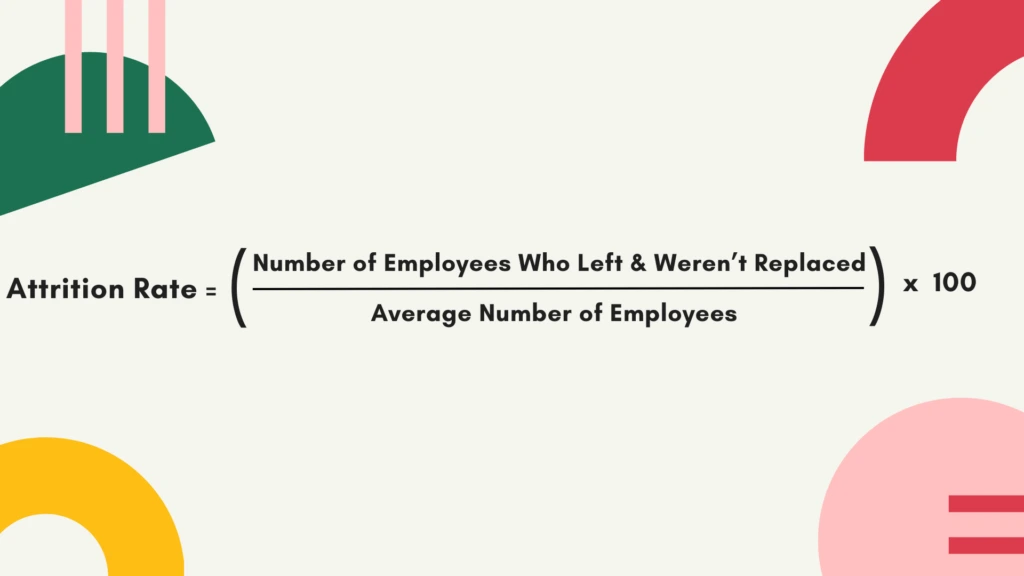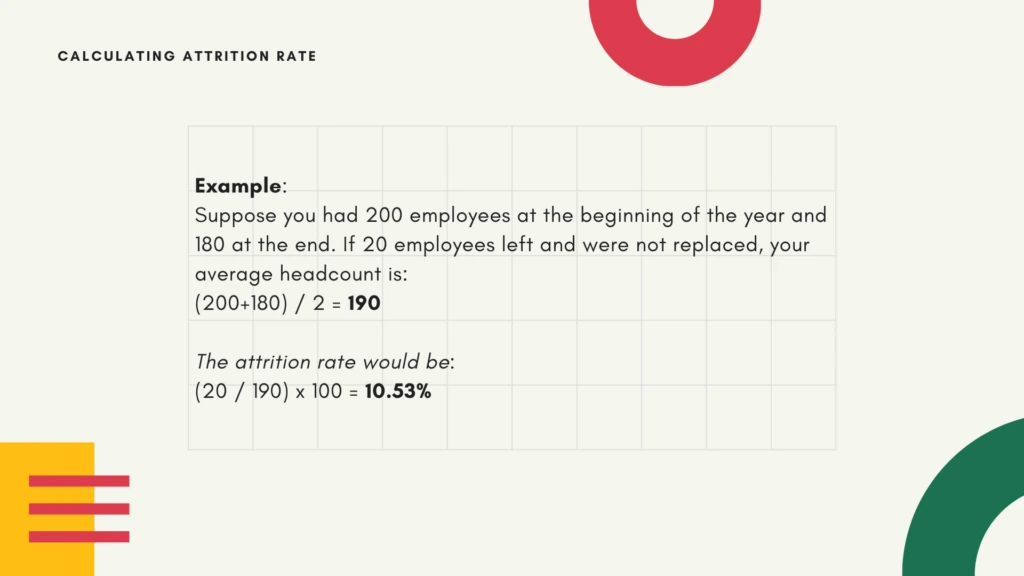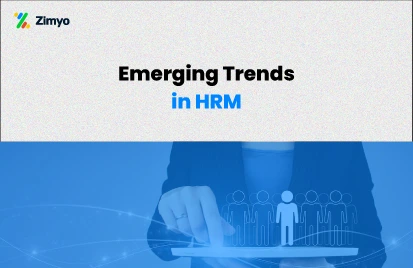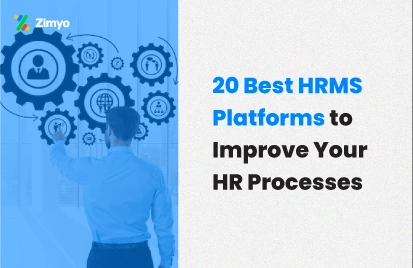In today’s times, we’re facing one of the most significant talent shortages in recent history. The pandemic’s ripple effects, rapid digitalization, and evolving employee expectations have all collided, creating a perfect storm for recruitment and talent retention. The competition for top talent is fierce, and it’s clear that businesses need to adapt quickly. You might be wondering, “How can my organization stay ahead in this intense talent battle?” One key strategy involves understanding and managing your attrition rate. It is essential for effective HR management. Attrition rate is more than just a number. It’s a reflection of how well your organization is handling employee retention. So, how do you get your hands on this vital metric? Let’s go into the details…
What is Attrition Rate?
Firstly, attrition rate measures how many employees leave your company over a given period. In essence, it indicates how much your workforce is shrinking. Typically, you calculate this by looking at the number of employees who leave and are not replaced, divided by the average number of employees, and then multiplying by 100. It’s a straightforward formula but provides critical insights into your company’s health.
Why is this important? Attrition rate helps gauge the effectiveness of your HRMS (Human Resource Management System) and overall employee satisfaction. When you see a rising attrition rate, it’s a signal that something might be amiss in your HR strategies or workplace environment.
What Are the Different Types of Attrition Rate?
To fully grasp attrition rate, you need to understand its different types. Each type provides unique insights into various aspects of your workforce dynamics.
1. Voluntary Attrition Rate
Voluntary attrition occurs when employees leave on their own accord. This could be due to:
- Resignation: Employees decide to move on for personal growth or new opportunities.
- Retirement: Employees retire after a fulfilling career.
- Relocation: Employees move to a new location that makes commuting impractical.
- Personal Reasons: Life changes that necessitate leaving the job.
How do you handle this? Understanding why employees leave voluntarily can help you improve retention strategies. For instance, if many employees leave due to inadequate pay, you might need to reassess your compensation packages.
2. Involuntary Attrition Rate
Involuntary attrition is when employees leave due to employer actions. This can include:
- Discharges: Terminations due to performance issues.
- Layoffs: Reductions in workforce due to financial constraints or restructuring.
- Eliminated Positions: Jobs that are removed as a result of organizational changes.
What can you do? For involuntary attrition, ensure that your processes are fair and transparent. Proper documentation and clear communication can mitigate the impact of layoffs and terminations.
3. Internal Attrition Rate
Internal attrition happens when positions are not backfilled after promotions, role changes, or department shifts. This can lead to:
- Work Distribution Issues: Overloading other employees with additional tasks.
- Production Bottlenecks: Slowdowns due to lack of personnel in key roles.
How should you address this? Keep track of internal movements and ensure that replacements or adjustments are made promptly to avoid workflow disruptions.
4. Demographic-Specific Attrition Rate
This type of attrition looks at how different demographic groups are affected. For example:
- Gender-Based Attrition: If a particular gender group has higher attrition, it might indicate issues with workplace inclusivity.
- Age-Based Attrition: If older employees are leaving more frequently, it might signal issues with career advancement or work-life balance.
What’s the takeaway? Use HR software to analyze attrition data by demographics. This can help in developing targeted strategies to address specific group needs and improve overall workplace inclusivity.
Causes of High Employee Attrition Rate & How to Resolve Them
Understanding the causes behind high employee attrition can help you take proactive steps to address them. Here are common reasons:
- Inadequate Pay or Benefits: Compare your compensation packages with industry standards. If your offerings fall short, employees might look elsewhere.
- Limited Growth & Development Opportunities: Employees need to see a clear career path. Invest in training and development programs to enhance skills and career progression.
- Lack of Feedback, Recognition, and Rewards: Regular feedback and recognition are crucial. Create a robust system for performance reviews and rewards.
- Poor Work-Life Balance: Ensure employees have a manageable workload and flexible work options if possible.
- Unsupportive Workplace Culture: Foster a positive, inclusive culture. Conduct surveys to gauge employee sentiment and act on feedback.
How Can We Calculate the Attrition Rate?
Calculating the attrition rate involves a simple formula:
- Determine the Time Frame: Decide on the period for which you want to calculate the attrition rate (e.g., annually, quarterly).
- Count Departures: Count the number of employees who left and were not replaced during this period.
- Calculate the Average Headcount: Find the average number of employees during the same period. This can be done by adding the number of employees at the start and end of the period and dividing by two.
- Apply the Formula: Use the formula to calculate the attrition rate.

.

Need for Calculating Attrition Rate
Why should you calculate the attrition rate? Monitoring this metric is crucial for several reasons:
- Strategic Workforce Planning: Helps in planning recruitment and understanding future workforce needs.
- Identifying Problems: A rising attrition rate can signal issues in workplace culture or management.
- Improving Retention: Helps in developing targeted strategies to retain top talent.
So, how do you leverage this information? Use it to inform HR policies, improve employee satisfaction, and reduce turnover costs.
What is the Difference Between Employee Attrition Rate and Turnover?
Understanding the difference between attrition and turnover is essential for accurate reporting and strategy development.
- Attrition Rate: Measures the rate at which employees exit and are not replaced. It reflects long-term trends and structural issues within the company.
- Turnover Rate: Focuses on the rate at which employees leave and are replaced within a short period. It’s more about maintaining minimum staffing levels and can be influenced by immediate factors.
For example, a retail store might experience high turnover rates due to the nature of the industry. But if they’re not replacing these employees quickly, their attrition rate might still be low.
What is an Acceptable Level of Attrition Rate?
Determining an acceptable level of attrition varies widely across industries, company sizes, and business models. However, understanding what constitutes a reasonable rate can help you benchmark your organization’s performance and address any potential issues effectively.
Industry Benchmarks
Typically, industry standards provide a useful baseline. For instance:
- Retail and Hospitality: These sectors often experience higher turnover rates, with acceptable levels ranging from 30% to 60%. This higher attrition is due to the nature of the jobs and seasonal fluctuations.
- Technology and Finance: In contrast, industries such as technology and finance generally see lower attrition rates, with 10% to 20% considered acceptable. These fields require specialized skills and often have more significant investments in employee development.
Company Size and Structure
The size and structure of your company also play a role. Smaller businesses might face higher attrition rates simply due to the limited opportunities for advancement. Conversely, larger organizations with more structured career paths often experience lower attrition.
Role and Function
Different roles within a company may have varying attrition rates. Frontline positions or entry-level roles might have higher turnover compared to more senior or specialized roles. Evaluating attrition rates by role can provide insights into specific areas that may require targeted retention strategies.
Contextual Factors affecting Attrition Rate
Understanding the context behind the attrition rate is crucial. For example:
- Economic Conditions: During economic downturns, attrition rates might decrease as employees hold onto their jobs longer.
- Company Changes: Organizational restructuring or changes in company strategy can temporarily affect attrition rates.
Setting Your Benchmark of Attrition Rate
Ultimately, an acceptable level of attrition is one that aligns with your company’s strategic goals and operational needs. Regularly review your attrition data, compare it against industry benchmarks, and adjust your retention strategies accordingly. Monitoring these factors ensures you maintain a healthy balance, keeping your workforce stable while adapting to evolving business demands.
Why is it Important to Retain Talent (or to Maintain Low Attrition Rate)?
In today’s competitive job market, retaining talent is more critical than ever. Here’s why keeping your top performers should be a priority:
1. Navigating the Talent Shortage
The global talent shortage could reach 85 million workers by 2030. Replacing top employees is both challenging and costly. By retaining your best talent, you avoid the high costs of recruitment and the time investment needed for onboarding new hires.
2. Maintaining Productivity & Continuity
Experienced employees understand your company’s processes and culture, enhancing productivity and operational efficiency. New hires face a learning curve that can temporarily disrupt workflow, making it vital to keep seasoned staff for smoother operations.
3. Enhancing Employee Morale & Engagement
High turnover can negatively impact morale and disrupt team dynamics. A stable workforce fosters team cohesion and keeps employees engaged. When staff feel valued and see opportunities for growth, they are more likely to stay motivated and committed.
4. Building a Strong Employer Brand
A company with high turnover may struggle to attract top talent. A stable workforce enhances your employer brand, signaling that your organization is a great place to work. Satisfied employees can become brand ambassadors. Thus, helping to attract other skilled professionals.
5. Driving Business Growth & Innovation
Long-term employees often drive innovation and contribute valuable ideas. They possess deep industry knowledge and are more invested in the company’s success, helping to build a strong leadership pipeline and ensure strategic goals are met.
6. Adapting to Rapid Changes
Stability is an asset in a rapidly changing business environment. Experienced employees help navigate transitions and adapt to new challenges, ensuring that your company remains resilient and strategically aligned.
In summary, retaining talent is crucial for maintaining productivity, enhancing morale, strengthening your employer brand, and driving business growth in a dynamic market.
Enhancing Attrition Rate Management with HR Software
HR software and HRMS can play a significant role in managing and calculating attrition rate effectively. Features such as:
- Real-Time Data Tracking: Keeps track of employee movements and attrition metrics.
- Predictive Analytics: Helps forecast future attrition trends and identify at-risk employees.
- Comprehensive Reporting: Provides detailed insights into attrition by department, role, or demographic.
Why use HR software? It streamlines the process, provides accurate data, and helps in making informed decisions.
Conclusion
Calculating and understanding your attrition rate is vital for maintaining a healthy and productive workforce. By knowing how to calculate it, understanding its types, and addressing its causes, you can implement effective strategies to manage and reduce attrition. With the right HR software, you can streamline this process and make data-driven decisions to improve your organization’s overall performance.
Zimyo—The Leading HR Software
Willing to elevate your HR processes? Discover why over 2,000 businesses across 50+ countries trust Zimyo, the #1 HRMS platform for small and medium enterprises. With AI-powered tools, you can easily hire, engage, and pay your teams globally. Don’t just take our word for it—our 500,000+ users and 4.5+ average ratings on platforms like G2, Capterra, and Glassdoor speak volumes.
Schedule a demo today and see how Zimyo can transform your HR operations!
FAQs (Frequently Asked Questions)
To calculate the attrition rate this formula can be used:
Attrition Rate= No of Separations/ Average number of Employees*100
Suppose there were 200 employees in March. Over this period 30 employees left and you hired 20 more employees.
200-30+20=190
Average number of employees= 200+190/2= 195
Attrition Rate= 30/195*100= 15.38%
30% attrition rate means out of total 100 there were 30 employees who left the organization.
Attrition Rate= Number of Attritions/ Number of employees*100






